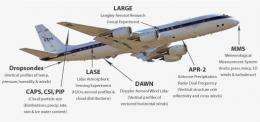Snapshot of activity inside NASA's first GRIP flight

Scientists, graduate students and NASA flight crew came together and took part in the first flight of the DC-8 aircraft in NASA's Genesis and Rapid Intensification Processes (GRIP) experiment on Tuesday, August 17, as it flew into the remnants of Tropical Depression Five over southern Louisiana. The inside of the aircraft buzzed with activity as they readied the various instruments for their first in-situ test.
GRIP is a NASA Earth science field experiment being conducted between August 15 and September 25 to better understand how tropical storms form and develop into major hurricanes. The NASA GRIP mission includes several NASA satellites, three aircraft and 14 different aircraft instruments. Nine of those instruments ride on the DC-8 aircraft.
The DC-8 departed at 11 a.m. EDT on August 17 from its base at the Fort Lauderdale, Fla. airport and headed west toward the remnants of Tropical Depression Five along the Gulf Coast. The excitement was building as the DC-8 neared the remnant low pressure area. The scientists onboard were looking forward to gathering their first round of data.
During the flight, Errol Korn deployed a dropsonde experiment over the Gulf of Mexico during the flight as Janel Thomas, a University of Maryland Baltimore County graduate student looked on. Dropsondes or Dropwinsondes are fitted with Global Positioning System receivers to measure the atmospheric state parameters (temperature, humidity, windspeed/direction, pressure) and location in 3 dimensional space during the sonde's descent once each half second. Measurements are transmitted to the aircraft from the time of release until impact with the ocean's surface.

In another part of the DC-8, Michael Kavaya, principal investigator for the DAWN experiment, from NASA's Langley Research Center, Hampton, Va., checked over data with Jeffrey Beyon also from NASA Langley. The DAWN experiment is also known as the Doppler Aerosol WINd lidar, DAWN will provide vertical profiles of components of 3-D wind in the region below the aircraft.
While many others attended to their instruments, meteorologists were checked the trajectory of weather patterns on a computer monitor during the flight.
After the first flight of the DC-8, the scientists and their new data headed back to base in Fort Lauderdale.
Provided by NASA's Goddard Space Flight Center


















